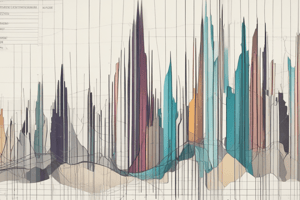Podcast
Questions and Answers
Match the following types of data with their descriptions:
Match the following types of data with their descriptions:
Qualitative Data = Data given in words to describe something Quantitative Data = Data given using numbers that counts or measures something Discrete Data = Quantitative data that can only take specific values Continuous Data = Quantitative data that can take any value within a range
Match the terms with their definitions:
Match the terms with their definitions:
Population = The whole set of things being studied Sample = A subset of the population used to collect data Sampling Frame = A list of all members of the population Census = A method that collects data about all members of a population
Match the type of data classification with their characteristics:
Match the type of data classification with their characteristics:
Age (Count) = Discrete data indicating how many years old a person is Age (Time) = Continuous data measuring how long a person has been alive The number of pets a student has = Discrete data The height of a student = Continuous data
Match the statistical terms with their explanations:
Match the statistical terms with their explanations:
Match the examples with their data types:
Match the examples with their data types:
Match the research methods with their descriptions:
Match the research methods with their descriptions:
Match the concepts with their examples:
Match the concepts with their examples:
Match the definitions with their corresponding terms:
Match the definitions with their corresponding terms:
Match the following advantages with their corresponding methods:
Match the following advantages with their corresponding methods:
Match the following disadvantages with their corresponding methods:
Match the following disadvantages with their corresponding methods:
Match the sampling techniques with their definitions:
Match the sampling techniques with their definitions:
Match the examples to their corresponding sampling methods:
Match the examples to their corresponding sampling methods:
Match the sampling methods with appropriate situations for use:
Match the sampling methods with appropriate situations for use:
Match the sampling types with their characteristics:
Match the sampling types with their characteristics:
Match the descriptions with the sampling terms:
Match the descriptions with the sampling terms:
Match the methods with their potential biases:
Match the methods with their potential biases:
Flashcards are hidden until you start studying
Study Notes
Data Types
- Qualitative Data: Descriptive information expressed in words rather than numbers (e.g., color of a teacher's car).
- Quantitative Data: Numerical data representing counts or measurements (e.g., number of pets a student has).
Specific Data Classifications
- Discrete Data: Countable quantitative data with specific values (e.g., coin flips before obtaining tails).
- Continuous Data: Measurable quantitative data that can take any value within a range (e.g., height of a student).
- Age Classification: Represents discrete when counting years old; continuous when measuring lifespan duration.
Population and Sampling Concepts
- Population: Entire set of items of interest (e.g., all French bulldogs for sleeping habit study).
- Sample: Subset of the population used for data collection (e.g., bulldogs from various cities).
- Sampling Frame: Complete list of all population members (e.g., company employees' names).
Parameters and Statistics
- Population Parameter: Unknown numerical value representing a characteristic of the population (e.g., mean height of all UK 16-year-olds).
- Sample Statistic: Computed value from sample data to estimate population parameters (e.g., mean height from 200 randomly selected 16-year-olds).
Data Collection Methods
- Census: Comprehensive data collection from all population members (e.g., national census conducted every 10 years).
- Advantages of Census: Produces fully accurate results.
- Disadvantages of Census: Time-consuming, costly, and can potentially deplete population members.
Sampling Techniques
- Sampling: Data collection from a subset of the population.
- Advantages of Sampling: More efficient and cost-effective than a census; reduces amount of data for analysis.
- Disadvantages of Sampling: Potential inaccuracies and bias may arise, possibly misrepresenting the population.
Sampling Methods
- Simple Random Sampling: Equal probability of selection for every group member, often using random number generators.
- Systematic Sampling: Selecting members at regular intervals from an ordered list (e.g., every 10th person).
- Stratified Sampling: Dividing population into distinct groups (strata) and random sampling from each (e.g., age ranges).
- Quota Sampling: Group-based sampling until predefined quotas are met (e.g., surveying a fixed number from each demographic).
- Opportunity (Convenience) Sampling: Utilizing available members who meet criteria (e.g., surveying passersby in public).
Appropriate Use of Sampling Techniques
- When to Use Simple Random Sampling: Ideal for avoiding bias in small populations or when requiring a small sample size.
Studying That Suits You
Use AI to generate personalized quizzes and flashcards to suit your learning preferences.




